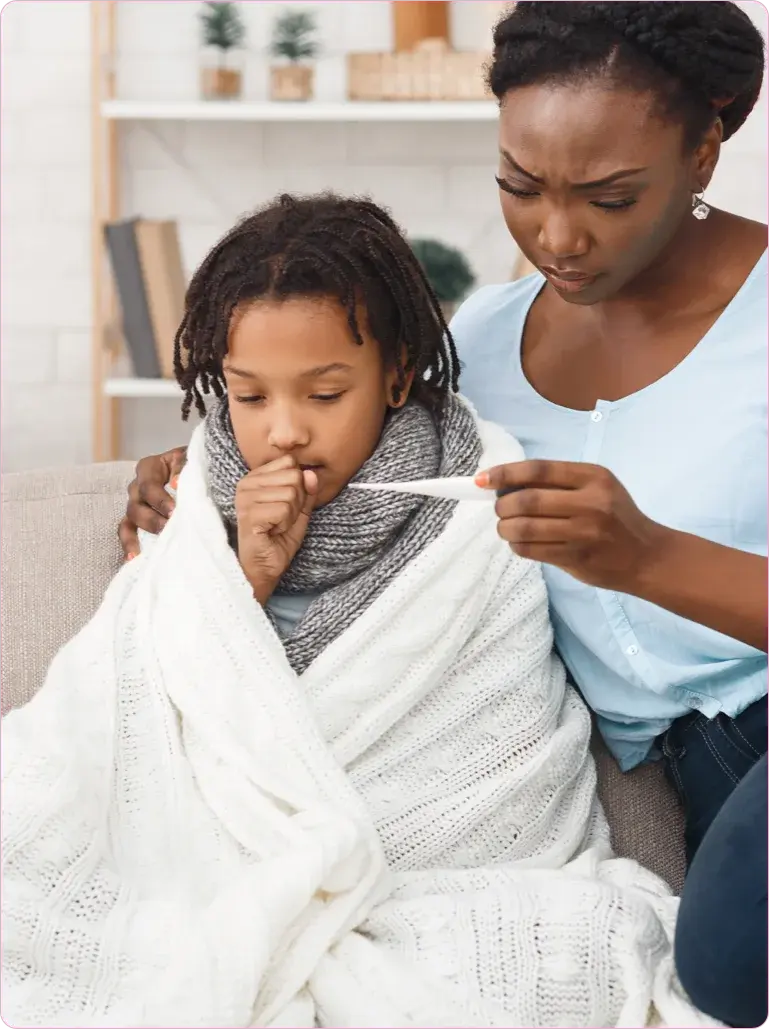Anyone who spends time around children will know that sniffles are common. In fact, it’s normal for a child to have eight or more colds every year. There are hundreds of viruses that cause colds floating around that young children will never have encountered before, meaning they’ve developed no immunity to them.
As your child builds their natural immunity, there are a few tips and tricks you can use to help manage symptoms. That said, most colds should clear up by themselves within one to two weeks. During those two weeks, it’s important to monitor your child’s symptoms to ensure they don’t get worse and consult a doctor if necessary.
Remember, colds and flu in children often differ from those in adults. For example:
Children get colds far more often than adults, with most adults only having two to four colds a year.
Sometimes it may seem as though your child has had a continuous or prolonged bout of cold, but they’ve actually had several separate minor infections with a short recovery between each.
In this article, we’ll explain:
Click here for more Tips and Advice for Parents
Causes of colds, flu and coughs in children
In most cases, a cough or cold is caused by a type of germ called a virus – and there are many different types of viruses that affect the nose and throat. These viruses are passed from person to person by coughing or sneezing, which releases the virus into the air.
You may find that your child seems to have a cough at the same time as a cold. This may be because the excess mucus from a cold trickles down the back of their throat, triggering a cough. Children typically have little to no immunity to the many viruses that cause coughs, colds and flus, making them more susceptible to catching them.
Cough, flu, and cold symptoms in kids
In most cases, children’s cough, cold and flu symptoms are like those of an adult. These can include:
Coughing – 30% of people with a cold or flu will also develop a cough, even after the nasal symptoms of a cold have cleared.
Runny nose – A runny nose is one of the most recognisable symptoms of cold and flu. The discharge from your child’s nose will likely start out clear and thin but may thicken and become darker in colour as the infection progresses.
A blocked nose – Many people also experience some nasal congestion as the virus causes swelling in the membranes of your nasal passages and sinuses .
A sore throat – Throat irritation or soreness is often one of the earliest symptoms of a cough, cold or flu virus. This symptom typically develops and clears up fairly quickly.
Sneezing – A common symptom of colds and flu, sneezing is one of the ways the virus passes from person to person. Make sure you catch your sneezes in a tissue then dispose of it and wash your hands to prevent the infection from spreading.
Breathing problems – When your child has a cold, you may notice they develop wheezing or noisy breathing. They may also breathe faster than normal.
Other symptoms are more common in children than they are in adults, for example:
A fever – If your child is unwell with a cough or cold, they may develop a fever. This is typically a high temperature of 37.9°C or above.
Fatigue – Children will often need additional sleep when they feel unwell.
Risk factors for colds, coughs and flu in children
There are many environmental and health conditions that can affect a child’s likelihood of developing a cough, cold or flu. Some of these will include:
The time of year – Colds tend to occur more frequently over the autumn and winter months, although it isn’t clear as to why.
Living arrangements – Children who live with smokers are often at increased risk of developing coughs and colds, and the colds they get may last longer.
Diabetes – If your child has pre-existing diabetes, they may be more prone to complications following a cough, cold or flu virus.
Asthma – Children with asthma may also be more vulnerable to complications from a cold, cough or flu.
How to help a child with a cough, cold or flu
While there isn’t a magic, catch-all cure for coughs, colds and flu, most cases tend to improve on their own in a matter of days or weeks . However, there are a few things you can do at home to help manage the symptoms of children’s coughs and colds.
We’ve got some key dos and don’ts for how to help a child with a cough:
Do:
Use kid’s cough medicine, such as infant cough syrup to help soothe a sore throat.
Use infant paracetamol and ibuprofen to help reduce nasal swelling and ease other aches and pains .
Encourage your child to drink more fluids as they can easily become dehydrated, especially if they have a fever .
Give them a warm lemon drink with honey for coughs. Mix the juice of half a lemon with one to two teaspoons of honey and add boiling water. Wait for the drink to cool so that it’s warm but not hot before giving it to your child. Don’t give honey to children under the age of 1 year.
Raise their pillow by putting books or bricks under the legs of their bed or placing a pillow under the mattress to help drain their sinuses.
Create a warm, moist atmosphere to help ease your child’s breathing if they have a blocked nose. You could use a humidifier or take your child into the bathroom and run a hot bath or shower before bed.
Don’t
Try to reduce your child’s fever by undressing them. Having a fever is part of the body’s natural immune response .
Sponge your child with water, as this can make their fever worse by making them shiver.
Give aspirin to children under the age of 16.
Preventing the spread of children’s coughs, colds, and flu
When children cough or sneeze into their hands or touch their runny nose, germs and viruses get onto their skin. They can then pass these germs around when they touch other objects, surfaces or people. Cold viruses can live on objects and surfaces for several hours, making it vital that children clean their hands after coughing or sneezing before touching anything else to stop the virus from spreading.
Unless your child is seriously unwell, it’s normally okay to send them to school if they have a cold or cough. Just be sure they understand the importance of washing their hands.
Here are some key tips to follow to minimise the risk of your child catching or spreading colds, coughs, and flu viruses:
Prevent the spread of cold viruses
Make sure you wash yours and your child’s hands regularly with soap and warm water. It’s a common piece of advice for good reason – 80% of infections spread by touch.
Clean and disinfect surfaces (such as toys, telephones, and door handles) regularly to get kill germs.
Encourage your child to cover their mouth with the crook of their elbow when coughing, and to use a tissue when sneezing or blowing their nose. This can prevent germs getting onto their hands in the first place.
Put used tissues in a bin as soon as possible, to prevent other people coming into contact with them.
Stay away from people who are sick. Reducing contact can help reduce your risk of catching infectious viruses.
When to keep your child home from school
If your child has a fever, keep them at home until it goes down.
You can still send your child to school if they have a sore throat. But if their sore throat is combined with a high temperature, they should stay at home until it goes away.
If your child’s symptoms worsen, consider keeping them at home to get the rest they need.
If you do keep your child at home, you must phone the school or nursery on the first day to let them know that your child will not be in and give them the reason.
When to see a doctor about cough, cold or flu symptoms in children
When your child is unwell, they may experience other symptoms outside of those you usually expect from the common cold and flu symptoms. If you notice your child developing any of the following symptoms, you should arrange to see your GP or healthcare professional:
A cough that lasts for three weeks or more.
If your child's temperature is very high, they feel hot to touch or are shivery. This could be a sign of a children’s chest infection which will require an antibiotics prescription.
Your child is breathing rapidly or seems to be working hard to breathe.
Your child’s lips turn blue.
Their coughing is so bad that they choke or vomit.
They cough up bloodstained phlegm or mucus.
If your child is extremely shivery or has aching muscles.
They continue to have a fever of 38.0°C or above for more than five days.
They develop a rash.
They are experiencing chest pains.
There are any symptom that you cannot explain.
Remember, you know your child better than anyone, so trust your instincts and seek advice as soon as you notice anything that concerns you.

